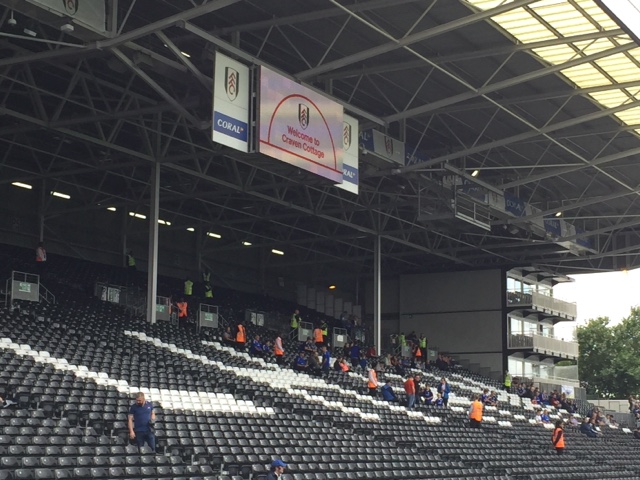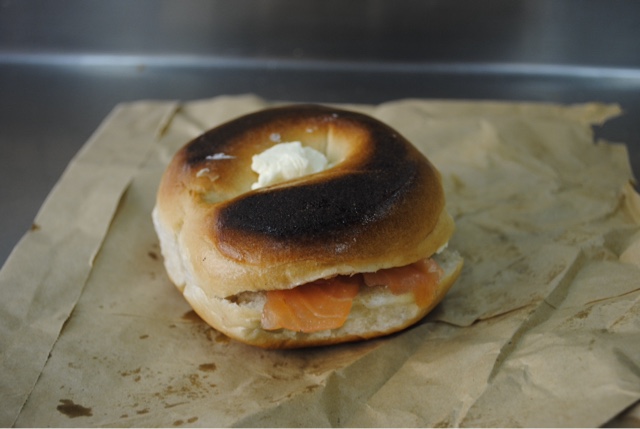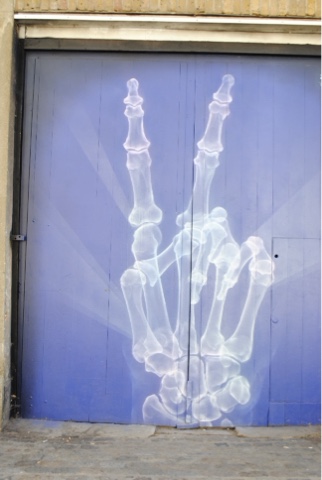This was the first time I had visited this museum and won't be the last. Located now near the Barbican, the museum will eventually expand and move to the old Smithfield market in the year 2021.
Entrance to the museum is free. There are free guided tours of certain areas of the museum. I did not get there early enough to obtain a ticket. You must collect the ticket on site. It is not announced ahead of time online which parts of the museum will be featured on the tour (and each tour covers a different area). You have to find out when you get there. Be prepared to go through a quick security check with a bag scanner as you enter the building.
I started out in the "pre-London" part of the museum, meaning before London was established as a city. If you are really into old tools, weapons and skeletons, this is the place for you. The focus was on settlements that popped up near the Thames River and inland. Remains of an old settlement in "Shepperton" were found with buried skeletons and tools.
As you can imagine there were many religious influences in London throughout its early history. Roman gods of course come to mind. Traveling soldiers and merchants brought with them the mystic gods of Asia and Egypt. Christianity became "official" around 312 AD.
A woman's skeletal remains was found buried there.
In the early days people were buried in the river or in earthen pits or mounds. Like other ancient civilizations their possessions were buried with them. This photo shows pots and tools that accompanied them.
Sacrifices were made to the supernatural after death by way of giving up a person's possessions at death.
Here are some old cremation vessels.
There was mention of Queen Boudica's revolt around 60 AD. I was not familiar with it. Boudica was queen of a British Celtic tribe. She and her sisters were promised that they would jointly be in charge of the kingdom along with the Roman emperor when their father died. That did not happen. The Romans took over. The queen lead a revolt and destroyed many of the Roman settlements in Britain, including Londinium (London). The Romans eventually caught up with the queen and her troops and defeated them. The queen either killed herself or died of illness. They are not sure.Around that same time (60 AD) a settlement developed along the Thames. This was London. The picture below shows development on both sides of the river with the north bank (on the left) being more developed than the south (on the right).
A fire around 60 AD destroyed that settlement. A second settlement there followed. Here is a picture of London from around 120 AD. Notice more development here on both sides of the river.
The north bank is on the right. Note the bridge connecting the banks. It was wooden and built near the present day London Bridge. Warehouses were built on both banks. Trading with other countries was expanding. The British exported oysters, hunting dogs, lead, wool clothes and slaves to Rome. In return they received the skills and services of Romans who came there. One trade route took advantage of the Rhine River waterway. The sea route around France and Spain could be dangerous due to poor weather.
In one of the rooms there was a video playing about the buried remains of a Roman amphitheater in London. The remains are in the basement of the Guildhall Art Gallery and you can go see them for free.
All sorts of barbaric "entertainment" happened there.
On the north bank of London (and inland) a civic center was built around 70 AD. A "forum" was built that contained markets, shops and offices. A "basilica" or town hall was built. London was getting organized.
Roman bath houses (both public and private) existed on the north and south banks. A private one at Billingsgate can still be visited. There are tours.
A fort was built around 90 AD. It housed the governor's guard and 1,000 soldiers (civil servants). The fort was built into a Roman wall that encircled the city of London. There were gates and towers in the wall. From the Museum of London you can see part of the western wall of the fort out the window.
The fort stayed active until around 120 AD. This is what is left of it.
For a while Britain separated from the Roman Empire and was part of the independent Gallic Empire from 259-74 AD. Other territories in that empire were Germania, Gaul and Hispania. After that period the Romans came back. I must confess that I am not very knowledgeable about early British history, so I must read up on it.
An interesting part of the Roman period of Britain's history is depicted in a section on daily life. A poster about food caught my attention.
The floors of homes during this time were often mosaics. Here is a dining room from around 300 AD.
Their heating system in homes was ingenious. The floors were raised. Hot air was blown underneath the floor and came up the walls through tubes. The hot air was released into the room that way.
A new wall was built around London between 240-360 AD. More towers were built. Sculptured stones were often "recycled" and used in construction of this new wall. An example is a sculpture of 4 Mother goddesses that was re-used as building material for the wall near Blackfriars.
Once again Britain broke ties with the Roman Empire from 286-96 AD. They wanted more independence, less oppression etc. (Some say it sounds like an ancient Brexit!) The Romans forcefully came back and destroyed many public buildings as punishment for this rebellion.
It is about this time in Britain's history that I quit. I was saturated with too many facts. Next up for me are the medieval, Victorian and "modern" sections of the museum. Plan to spend several days here if you want to see most of the museum. It is time well spent.
There is another branch of this museum called the Museum of the Docklands (in London). It deals with the maritime history of London. I did not make it there. I imagine it is very good.



















































